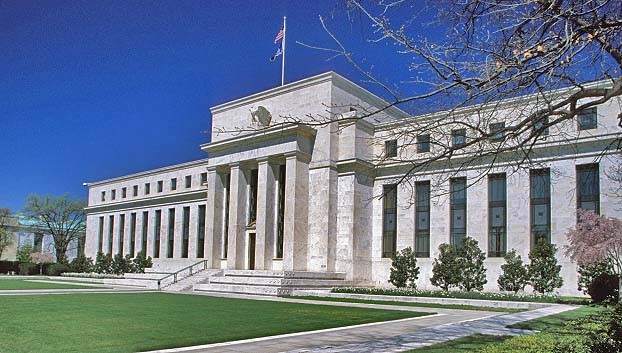When The Federal Reserve Intervenes (And Why)
Post on: 16 Март, 2015 No Comment

On the Federal Reserve System’s (FRS) website, it states that part of the board of governors’ mission is maintaining the stability of the financial system and containing systematic risk that may arise in financial markets. Similar to one of the Fed’s other missions of maintaining price stability (containing inflation) while promoting economic growth, maintaining the stability of the financial system and containing systematic risk is a topic of great debate among financial market participants, students of economics and the financial press. In this article we’ll look at a few of the Fed’s more famous words and actions surrounding financial markets and systematic risk. (For more, read The Federal Reserve’s Fight Against Recession .)
Irrational Exuberance
On December 5, 1996, when the former chairman of the Federal Reserve, Alan Greenspan. spoke his famous phrase about irrational exuberance , stock markets across the world fell. He actually used the term in the following rhetorical question he posed to his audience, But how do we know when irrational exuberance has unduly escalated asset values, which then become subject to unexpected and prolonged contractions as they have in Japan over the past decade? Adding, We as central bankers need not be concerned if a collapsing financial asset bubble does not threaten to impair the real economy, its production, jobs and price stability. The stock market in Tokyo, which was open as he gave this speech, fell sharply, and closed down 3%. Hong Kong also fell 3%. Then markets in Frankfurt and London fell 4% and the U.S. continued the trend and fell 2% at the opening of trade.
Long-Term Capital Management (LTCM) was founded in 1994 as an arbitrage fund by a group of well-known and successful Wall Street professionals, including 1997 Nobel Memorial Prize-winning economists Robert Merton and Myron Scholes. As an arbitrage fund, Long-Term Capital Management used highly leveraged trading positions to exploit statistically calculated pricing irregularities, primarily in bond markets. By 1997, LTCM’s assets had grown to $120 billion with a capital base of $7.3 billion, which equaled an asset-to-equity ratio of 16:1. As LTCM’s assets and equity grew, so did its willingness to take increasingly risky trading positions. In 1998, following the Russian debt crisis, disaster struck. Long-Term Capital Management’s asset-to-equity ratio increased dramatically to 45:1 on trading losses. (Read Massive Hedge Fund Failures to see some more stories of spectacular meltdowns.)
Fearing the systematic risk to the entire financial system that might result in the collapse of LTCM, on September 20, 1998, the Federal Reserve stepped in by organizing a consortium of 14 of LTCM’s creditors, which consisted of Wall Street investment banks and financial firms. The consortium bought and took control of LTCM. Some accused the Fed of bailing out the fund. Congressional hearings were held, in which Alan Greenspan defended the Fed’s action in saying that the LTCM episode was one of those rare occasions when financial markets seize up and temporary ad hoc responses are required. Whether the failure of Long-Term Capital Management needed a response from the Federal Reserve is still hotly debated.
The Liquidity Crisis of 2008
In the fall of 2007 and the spring of 2008, the credit markets came to a near standstill as financial firms took large losses on mortgage bonds. leveraged loans and other assets. Markets deleveraged, some structured securities traded for pennies on the dollar, and a general liquidity crisis ensued. On March 16, 2008, the Federal Reserve orchestrated the purchase of Bear Stearns by JPMorgan Chase to avert the eminent next-day filing of bankruptcy by Bear Stearns. As part of the deal, the Federal Reserve took the extraordinary step of issuing JPMorgan Chase a $29 billion non-recourse loan for the purchase of Bear Stearns’ riskiest mortgage assets. Under the agreement, JPMorgan Chase would take the first billion-dollar loss on the total portfolio of $30 billion assets, and the Federal Reserve would take the rest of the losses is they materialized. Clearly, the Federal Reserve felt that the failure of Bear Stearns presented systematic risk to the entire financial system and economy. (For related reading, see Dissecting The Bear Stearns Hedge Fund Collapse and Who Is To Blame For The Subprime Crisis? )
In addition to orchestrating the JPMorgan Chase/Bear Stearns deal, the Federal Reserve used the following rarely used tools at its disposal to facilitate the flow of capital in credit markets. These included:
- Reducing the cost and increasing the allowable term of discount window credit to commercial banks
- Increasing the size of term auction facility (TAF), through which credit is auctioned to depository institutions
- Initiating a term securities lending facility (TSLF), which allows primary dealers to swap less-liquid mortgage-backed securities for more-liquid Treasury securities
- Creating the primary dealer credit facility, which is similar to the discount window but is accessible to primary dealers and reduces the federal funds rate
A Moral Hazard
In preventing the bankruptcy filing of Bearn Stearns, many believe that the Federal Reserve created a moral hazard. The term moral hazard refers to the belief that there is some probability that one’s actions (financial decisions) will be insulated from risk (the Federal Reserve will step in to prevent bankruptcy), they will be affected by that belief. In other words, a mutual fund, hedge fund. securities dealer or money manager might be willing to take risks they otherwise would not take because they believe the Federal Reserve will backstop those risks.
Conclusion
Based on its past actions, it is clear that the Fed is willing to step in — and even take fairly drastic action — to protect the U.S. economy from suffering major volatility. However, if economic problems do not pose systematic risk for the U.S. economy, the Fed is less likely to intervene.














